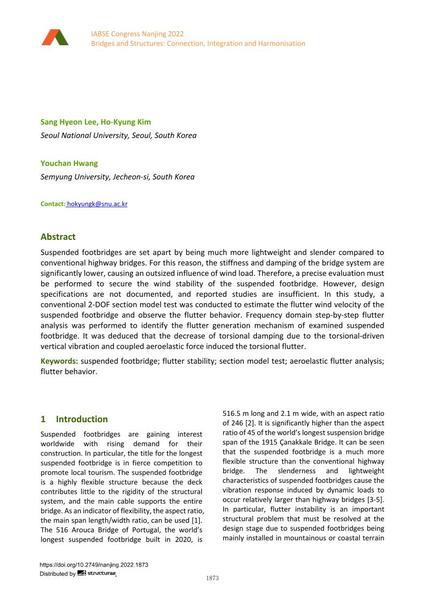Flutter Behavior and Stability Evaluation of Suspended Footbridge through Wind Tunnel Experiments and Aeroelastic Flutter Analysis

|
|
|||||||||||
Bibliografische Angaben
| Autor(en): |
Sang Hyeon Lee
(Seoul National University, Seoul, South Korea)
Ho-Kyung Kim Youchan Hwang (Semyung University, Jecheon-si, South Korea) |
||||
|---|---|---|---|---|---|
| Medium: | Tagungsbeitrag | ||||
| Sprache(n): | Englisch | ||||
| Tagung: | IABSE Congress: Bridges and Structures: Connection, Integration and Harmonisation, Nanjing, People's Republic of China, 21-23 September 2022 | ||||
| Veröffentlicht in: | IABSE Congress Nanjing 2022 | ||||
|
|||||
| Seite(n): | 1873-1878 | ||||
| Anzahl der Seiten (im PDF): | 6 | ||||
| DOI: | 10.2749/nanjing.2022.1873 | ||||
| Abstrakt: |
Suspended footbridges are set apart by being much more lightweight and slender compared to conventional highway bridges. For this reason, the stiffness and damping of the bridge system are significantly lower, causing an outsized influence of wind load. Therefore, a precise evaluation must be performed to secure the wind stability of the suspended footbridge. However, design specifications are not documented, and reported studies are insufficient. In this study, a conventional 2-DOF section model test was conducted to estimate the flutter wind velocity of the suspended footbridge and observe the flutter behavior. Frequency domain step-by-step flutter analysis was performed to identify the flutter generation mechanism of examined suspended footbridge. It was deduced that the decrease of torsional damping due to the torsional-driven vertical vibration and coupled aeroelastic force induced the torsional flutter. |
||||
| Copyright: | © 2022 International Association for Bridge and Structural Engineering (IABSE) | ||||
| Lizenz: | Die Urheberrechte (Copyright) für dieses Werk sind rechtlich geschützt. Es darf nicht ohne die Zustimmung des Autors/der Autorin oder Rechteinhabers/-in weiter benutzt werden. |
||||


